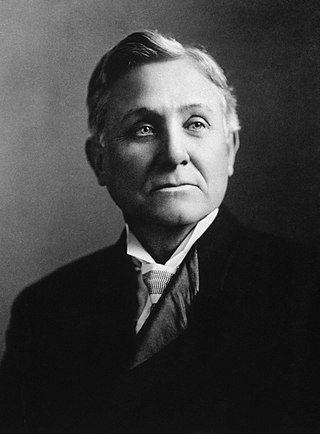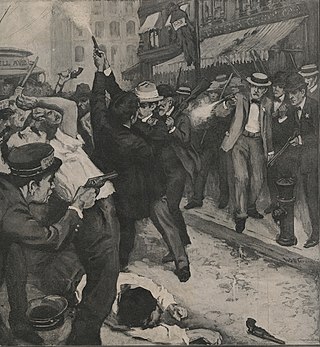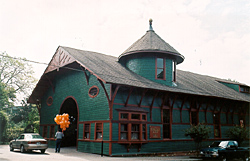Related Research Articles

The Amalgamated Transit Union (ATU) is a labor organization in the United States and Canada that represents employees in the public transit industry. Established in 1892 as the Amalgamated Association of Street Railway Employees of America, the union was centered primarily in the Eastern United States; today, ATU has over 200,000 members throughout the United States and Canada.

The history of Atlanta dates back to 1836, when Georgia decided to build a railroad to the U.S. Midwest and a location was chosen to be the line's terminus. The stake marking the founding of "Terminus" was driven into the ground in 1837. In 1839, homes and a store were built there and the settlement grew. Between 1845 and 1854, rail lines arrived from four different directions, and the rapidly growing town quickly became the rail hub for the entire Southern United States. During the American Civil War, Atlanta, as a distribution hub, became the target of a major Union campaign, and in 1864, Union William Sherman's troops set on fire and destroyed the city's assets and buildings, save churches and hospitals. After the war, the population grew rapidly, as did manufacturing, while the city retained its role as a rail hub. Coca-Cola was launched here in 1886 and grew into an Atlanta-based world empire. Electric streetcars arrived in 1889, and the city added new "streetcar suburbs".

Asa Griggs Candler Sr. was an American business tycoon and politician who in 1888 purchased the Coca-Cola recipe for $238.98 from chemist John Stith Pemberton in Atlanta, Georgia. Candler founded The Coca-Cola Company in 1892 and developed it as a major company.

The International Brotherhood of Electrical Workers (IBEW) is a labor union that represents approximately 775,000 workers and retirees in the electrical industry in the United States, Canada, Guam, Panama, Puerto Rico, and the US Virgin Islands; in particular electricians, or inside wiremen, in the construction industry and lineworkers and other employees of public utilities. The union also represents some workers in the computer, telecommunications, and broadcasting industries, and other fields related to electrical work.

The Coal strike of 1902 was a strike by the United Mine Workers of America in the anthracite coalfields of eastern Pennsylvania. Miners struck for higher wages, shorter workdays, and the recognition of their union. The strike threatened to shut down the winter fuel supply to major American cities. At that time, residences were typically heated with anthracite or "hard" coal, which produces higher heat value and less smoke than "soft" or bituminous coal.
The Atlanta Transit Company (ATC) was a public transport operator based in Atlanta, Georgia, which existed from 1950 to 1972. It was the immediate predecessor of the Metropolitan Atlanta Rapid Transit Authority (MARTA).

Joel Hurt (1850–1926) was an American businessman. He was the president of Trust Company of Georgia, and a developer in Atlanta. He was one of the many founders of SunTrust Bank.
The Omaha Traction Company was a privately owned public transportation business in Omaha, Nebraska. Created in the early 1900s by wealthy Omaha banker Gurdon Wattles, the company was involved in a series of contentious disputes with organized labor.

The Indianapolis streetcar strike of 1913 and the subsequent police mutiny and riots was a civil conflict in Indianapolis, Indiana. The events began as a workers strike by the union employees of the Indianapolis Traction & Terminal Company and their allies on Halloween night, October 31, 1913. The company was responsible for public transportation in Indianapolis, the capital city and transportation hub of the U.S. state of Indiana. The unionization effort was being organized by the Amalgamated Street Railway Employees of America who had successfully enforced strikes in other major United States cities. Company management suppressed the initial attempt by some of its employees to unionize and rejected an offer of mediation by the United States Department of Labor, which led to a rapid rise in tensions, and ultimately the strike. Government response to the strike was politically charged, as the strike began during the week leading up to public elections. The strike effectively shut down mass transit in the city and caused severe interruptions of statewide rail transportation and the 1913 city elections.

Julia Sarsfield O'Connor (1890–1972) was an American labor leader and head of the National Telephone Operators' Department of the International Brotherhood of Electrical Workers (IBEW). She spent her entire forty-five-year career in the labor movement.

The St. Louis streetcar strike of 1900 was a labor action, and resulting civil disruption, against the St. Louis Transit Company by a group of three thousand workers unionized by the Amalgamated Street Railway Employees of America.

From 1895 to 1929, streetcar strikes affected almost every major city in the United States. Sometimes lasting only a few days, these strikes were often "marked by almost continuous and often spectacular violent conflict," at times amounting to prolonged riots and weeks of civil insurrection.
The 1920 Alabama coal strike, or the Alabama miners' strike, was a statewide strike of the United Mine Workers of America against coal mine operators. The strike was marked by racial violence, and ended in significant defeat for the union and organized labor in Alabama.

The Atlanta & Edgewood Street Railroad Company of Atlanta, Georgia was organized in 1886 by Joel Hurt, C. W. Hubner, H. E. W. Palmer, W. P. Inman, Peter Lynch, R. C. Mitchell, Asa Griggs Candler, J. P. McDonald, J. G. Reynolds, A. F. Moreland, and P. H. Harralson. It was originally authorized to run horsecars along Foster Street to what was then the separate village of Edgewood.

William Daniel Mahon (1861–1949) was a former coal miner and streetcar driver who became president of the Amalgamated Association of Street Railway Employees of America, now the Amalgamated Transit Union.
The Pacific Electric Railway strike of 1903 was an industrial dispute between Mexican tracklayers and their employers on the construction of the Main Street streetcar line in Los Angeles. The dispute began on April 24 when the workers, known as the "Traqueros", demanded higher wages to match those of the European immigrants working on the same project, and stopped work. It ended on April 29 when the union organising the strike failed to persuade workers on rest of the streetcar system to join the strike, and the labourers returned to work.

The Los Angeles streetcar strike of 1919 was the most violent revolt against the open-shop policies of the Pacific Electric Railway Company in Los Angeles. Labor organizers had fought for over a decade to increase wages, decrease work hours, and legalize unions for streetcar workers of the Los Angeles basin. After having been denied unionization rights and changes in work policies by the National War Labor Board, streetcar workers broke out in massive protest before being subdued by local armed police force.

The 1910 streetcar strike was a union protest against labor practices by the Columbus Railway and Light Co. in Columbus, Ohio in 1910. The summertime strike began as peaceful protests, but led to thousands rioting throughout the city, injuring hundreds of people.
The 1914–1915 Fulton Bag and Cotton Mills strike was a labor strike involving several hundred textile workers from the Fulton Bag and Cotton Mills in Atlanta, Georgia, United States. The strike, which involved about 500 millworkers, began on May 20, 1914, and ended almost a year later on May 15, 1915, in failure for the strikers.
Workers for the Scripto company in Atlanta, Georgia, United States, held a labor strike from November 27, 1964, to January 9, 1965. It ended when the company and union agreed to a three-year contract that included wage increases and improved employee benefits. The strike was an important event in the history of the civil rights movement, as both civil rights leaders and organized labor activists worked together to support the strike.
References
- 1 2 3 Scott & Guynn 2000, p. 439.
- 1 2 Martin 1976, p. 60.
- 1 2 Scott & Guynn 2000, p. 440.
- ↑ Kuhn, Joye & West 1990, p. 14.
- 1 2 3 Scott & Guynn 2000, p. 441.
- ↑ Kemp 2002, p. 202.
- 1 2 Scott & Guynn 2000, p. 447.
- 1 2 3 4 5 Garrett 1969, p. 687.
- 1 2 3 4 Kemp 2002, p. 203.
- ↑ Kuhn, Joye & West 1990, pp. 14, 17.
- 1 2 Scott & Guynn 2000, p. 442.
- ↑ Garrett 1969, p. 687–688.
- 1 2 3 4 5 6 Garrett 1969, p. 688.
- ↑ Kemp 2002, pp. 202–203.
- 1 2 Scott & Guynn 2000, p. 443.
- ↑ Kuhn, Joye & West 1990, pp. 17, 19.
- ↑ Scott & Guynn 2000, p. 445.
- ↑ Scott & Guynn 2000, p. 448.
- ↑ Kuhn, Joye & West 1990, p. 17.
- ↑ Kemp 2002, p. 208.
- ↑ Martin 1976, p. 62.
- ↑ Scott & Guynn 2000, p. 446.
- ↑ Martin 1976, p. 64.
- ↑ Kemp 2002, p. 211.
- ↑ Scott & Guynn 2000, p. 450.
- 1 2 Scott & Guynn 2000, p. 452.
- ↑ Garrett 1969, p. 689.